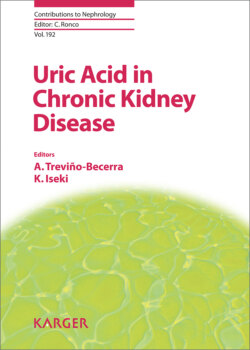Читать книгу Uric Acid in Chronic Kidney Disease - Группа авторов - Страница 8
На сайте Литреса книга снята с продажи.
Introduction
ОглавлениеThe idea of conducting a scientific meeting devoted to uric acid and chronic renal diseases was developed during the 8th and 9th Congresses of Uremia Toxicity and Research held in Okinawa, Japan, and Guadalajara, Mexico. In April 2016, during the 17th international Congress of Nutrition and Metabolism of Renal Diseases in Okinawa, a committee was formed with Prof. Kunitoshi Iseki and myself as the chairmen. Faculty members were invited to plan an interesting program, the products of which are published in this book.
Unfortunately, for various reasons, the symposium had to be cancelled just a few weeks before its scheduled event. However, the authors decided to remain true to their commitment to make possible the publication of their work, for which I am grateful to them all.
More than 30 years ago, in order to become a member of the National Academy of Medicine in Mexico, I presented my work relating to studies performed on 23 patients with uric acid reduction. This was achieved through an isocaloric, low-protein, and purine diet, as well as high doses of allopurinol, resulting in a blood urea reduction of 15–20% and a slightly increased creatinine clearance of up to 15–20%. Since then, we have routinely used the findings of those studies to acquire the benefits of low blood uric acid in our patients, which from the initiation of treatment provides relief through the reduction of some of their symptoms, mainly related to the gastrointestinal system. This in turn allows them to feel better and more able to cope with their diets.
This book includes chapters relating to new uric acid concepts in tubular transport and the early recognition of renal lesions due to an environmental and genetic predisposition to high blood uric acid. Also covered are the effects of high blood uric acid in preeclampsia, metabolic syndrome, diabetes, high blood pressure in the young, and the relationship between uric acid and vitamin D.
Interesting discussion is included of uric acid as a factor in the acceleration of renal diseases, and the effects of hyperuricemia on the progression of chronic renal failure. The benefits of low uric acid in the prognosis of chronic uremia are also considered. Finally, interesting observations from a study group that achieved low blood uric acid values through specific diets and the correct prescription of old and new drugs are presented.
Recent literature features several papers with substantial information concerning the relationship of acute kidney injury and the rejection of renal transplantation due to hyperuricemia. This latest book in the Contributions to Nephrology series offers the reader access to the most up-to-date scientific information, as well as stimulating discussion with which to develop further research in this field. It is hoped that the knowledge provided will help procure new insights into the role of uric acid in renal damage, and how it can be treated and prevented.
Alejandro Treviño-Becerra, Mexico City
Kunitoshi Iseki, Okinawa
